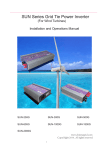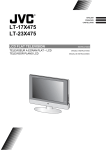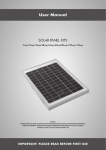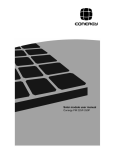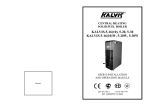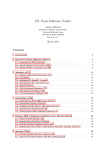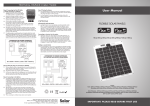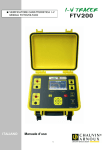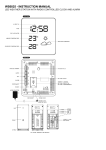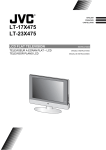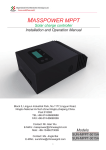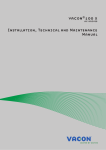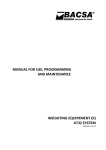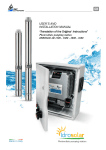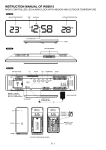Download User Manual for SUN Grid Tie Inverter
Transcript
SUN Series Grid Tie Power Inverter Installation and Operations Manual SUN-250G SUN-300G SUN-500G SUN-600G SUN-1000G SUN-1500G SUN-2000G www.chinesegrid.com Copy Right 2013, All rights reserved 1 Table of Contents Sunshine Grid Tie Inverter Models ----------------------------------------------------------------------------------3 Model Name Description -------------------------------------------------------------------------------------4 Important Safety Information-------------------------------------------------------------------------------------------4 Safety Instruction----------------------------------------------------------------------------------------------------------4 Instruction of Sunshine Grid Tie Inverter ---------------------------------------------------------------------------5 Advantage of Sunshine Grid Tie System --------------------------------------------------------------------------6 Sunshine Grid Tie Inverter Installation ----------------------------------------------------------------------------7 Installation Procedure ---------------------------------------------------------------------------------------------------8 Step 1 Considering the Total Capacity of the grid tie power system that you need-----------8 Step 2 Choosing Applicable Solar panels for Sunshine Grid Tie Inverter------------------------9 Step 3 Selecting Accessory for Grid Tie Power System installation------------------------------10 Step 4 Selecting Correct Model of Sunshine Grid Tie Inverter-------------------------------------11 Step 5 - Installing Solar Panels to suitable place ------------------------------------------------------13 Step 6 - Installing Sunshine Grid Tie Inverter to suitable place -----------------------------------13 Step 7 - Connecting Sunshine Grid Tie Power System with Cables and Connectors--------13 Step 8 – Grounding the system -----------------------------------------------------------------------------13 Step 9 – Connecting the PV modules after complete from Step1 to Step8---------------------13 Installing larger capacity of grid tie power system----------------------------------------------------------------16 Installing Sunshine Grid Tie Power System to Three Phases Utility Grid----------------------------------18 Starting DIY from small Grid Tie System---------------------------------------------------------------------------19 Layout of Sunshine Grid Tie Power Inverter ---------------------------------------------------------------------20 Technical Date of SUN Series Grid Tie Power Inverter---------------------------------------------------------23 Outline Drawing of SUN Series Grid Tie Power Inverter-------------------------------------------------------24 Weight and Dimension of SUN Series Grid Tie Power Inverter----------------------------------------------25 2 Sunshine Grid Tie Inverter Models Sunshine grid tie inverters include a series of models, refer to table 1. For more information of all models, refer to the Sunshine website (http://www.chinesegrid.com). Table 1, Sunshine Grid Tie Inverter Models Model Number Rated Power (Peak/Continuous) DC Input Voltage AC Output AC Output Peak Inverter Night Voltage Range Frequency Range Efficiency Power Consumption SUN-250G-L-U 250W / 225W 10.8V~30V 90V~140V 46Hz~65Hz 90% 0.1W SUN-250G-M-U 250W / 225W 22V~60V 90V~140V 46Hz~65Hz 91% 0.1W SUN-250G-L-E 250W / 225W 10.8V~30V 190V~260V 46Hz~65Hz 90% 0.1W SUN-250G-M-E 250W / 225W 22V~60V 190V~260V 46Hz~65Hz 91% 0.1W SUN-300G-L-U 300W / 270W 10.8V~30V 90V~140V 46Hz~65Hz 90% 0.1W SUN-300G-M-U 300W / 270W 22V~60V 90V~140V 46Hz~65Hz 91% 0.1W SUN-300G-L-E 300W / 270W 10.8V~30V 190V~260V 46Hz~65Hz 90% 0.1W SUN-300G-M-E 300W / 270W 22V~60V 190V~260V 46Hz~65Hz 91% 0.1W SUN-500G-L-U 500W / 450W 10.8V~30V 90V~140V 46Hz~65Hz 90% 0.2W SUN-500G-M-U 500W / 450W 22V~60V 90V~140V 46Hz~65Hz 91% 0.2W SUN-500G-L-E 500W / 450W 10.8V~30V 190V~260V 46Hz~65Hz 90% 0.2W SUN-500G-M-E 500W / 450W 22V~60V 190V~260V 46Hz~65Hz 91% 0.2W SUN-600G-L-U 600W / 540W 10.8V~30V 90V~140V 46Hz~65Hz 90% 0.2W SUN-600G-M-U 600W /540W 22V~60V 90V~140V 46Hz~65Hz 91% 0.2W SUN-600G-L-E 600W / 540W 10.8V~30V 190V~260V 46Hz~65Hz 90% 0.2W SUN-600G-M-E 600W /540W 22V~60V 190V~260V 46Hz~65Hz 91% 0.2W SUN-1000G-M-U 1000W / 900W 22V~60V 90V~140V 46Hz~65Hz 90% 0.5W SUN-1000G-H-U 1000W / 900W 45V~90V 90V~140V 46Hz~65Hz 92% 1.5W SUN-1000G-M-E 1000W / 900W 22V~60V 190V~260V 46Hz~65Hz 90% 0.5W SUN-1000G-H-E 1000W / 900W 45V~90V 190V~260V 46Hz~65Hz 92% 1.5W SUN-1500G-H-U 1500W / 1350W 45V~90V 90V~140V 46Hz~65Hz 92% 1.5W SUN-1500G-H-E 1500W / 1350W 45V~90V 190V~260V 46Hz~65Hz 92% 1.5W SUN-2000G-H-U 2000W / 1800W 45V~90V 90V~140V 46Hz~65Hz 92% 1.5W SUN-2000G-H-E 2000W / 1800W 45V~90V 190V~260V 46Hz~65Hz 92% 1.5W 3 Model Name description: SUN-XXXG-X-X AC Output Voltage Range, “U” is 90V~140V, “E” is 190V~260V DC Input Voltage Range, “L” is 10.8V~30V, “M” is 22V~60V, “H” is 45V~90V “G” is Abbreviation of Grid Tie Power Inverter The Rated Output Power The Title Name of Sunshine Products Some models also have “B” type, “B” means the model has LCD displayer. For example, the model SUN-1000G-H-E-B is Sunshine grid tie power inverter model that the rated power is 1000W, the DC input voltage range is 45V~90V, the AC output voltage range is 190V~260V, and with LCD displayer on the panel of the inverter. Important Safety Information Read this First ! This manual contains important instructions to follow during installation and maintenance of Sunshine Grid Tie Inverter. To reduce the risk of electrical shock, and to ensure the safe installation and operation of the Sunshine Grid Tie Inverter, the following safety symbols appear throughout this document to indicate dangerous conditions and important safety instructions. WARNING! This indicates a situation where failure to follow instructions may be a safety hazard or cause equipment malfunction. Use extreme caution and follow instructions carefully. NOTE: This indicates information particularly important for optimal system operation. Follow instructions closely. Safety Instructions WARNING! Be aware that the body of the Sunshine Grid Tie Inverters is the heat sink and can reach a temperature of 80℃ under extreme conditions. To reduce risk of burns, do not touch. - Perform all electrical installations in accordance with all local electrical codes and the National Electrical Code. - Be aware that only qualified personnel should install and/or replace Sunshine Grid Tie Inverters. - Do not attempt to repair the Sunshine Grid Tie Inverter; it contains no user serviceable parts. If it failed, please contact Sunshine customer service to obtain a RMA number and start the replacement process. Tampering with or opening the Sunshine Grid Tie Inverter will void the warranty. Before installing or using the Sunshine Grid Tie Inverter, please read all instructions and cautionary markings in the technical description and on the Sunshine Grid Tie Inverter and the PV-array. 4 Introduction of Sunshine Grid Tie Inverter Sunshine Grid Tie Power Inverter is the world’s most technologically advanced inverter for use in utility-interactive applications. This manual details the safe installation and operation of the Sunshine Grid Tie Inverter. This integrated system maximizes energy harvest, increases system reliability, and implifies design, installation and management. The small type solar grid tie power inverter can obtain the solar energy from solar panel, and can tie to the grid through its output cables with no extra equipment. The installation is very convenient and reliable. We call the system combining with small solar grid tie inverter and solar panels as ‘SGPV’. The system includes solar panels and small type grid tie inverter and installation kit. Solar panels can be mono silicon, polygon silicon, non-crystal film or any other material that can transform solar energy to electric energy. The power of grid tie inverter should be matched to the power of solar panels connected. So the power of SGPV is defined by its solar panels, it can be standardization according to the actual using. The inverter can be connected to any outlets of utility grid at house. The small grid tie inverter monitors the volume, frequency and phase of the home utility grid, then produce pure sine wave AC power that the frequency and phase are as same as the grid's, and the volume is a bit higher than the grid's, then according to the current controlled PWM, to control the output power to the grid. The small grid tie inverter just puts out power when the home grid is on. When the sun shines, the PV panel will produces DC voltage, and the grid tie inverter will change the DC voltage to AC voltage and puts out power to the home grid. When the total power of electric apparatus that are using in the house is larger than the output power of the inverters, these power from the inverters will be consumed in the house, this will slow down the power meter, otherwise, the difference of the output power of the inverter between the total used power of the apparatus will go out from the house to the out grid. Fig 1. A Small Grid Tie Power System with the Sunshine Grid Tie Inverter 5 Advantage of The Sunshine Grid Tie Power System There are many advantages of SGPV compare with the traditional grid tie power system. 1. Low cost and easy installation - SGPV can make full use of all types of buildings’ surface that face to the sun in the city as well as fast and easy installation of solar modules and grid tie inverter. It just needs very low maintenance costs. 2. Free combination - SGPV can be used as a separate grid tie system and can be setup as a large solar array with many of them. The quantity of SGPV in the array is just according to your desire. If you are planning to install a grid-tie PV system, in a general way, the solar array and inverter need to be carefully matched to ensure that the inverter’s voltage and power limits are not exceeded. When you want to increase more solar panels, and if the total power of the solar panels exceeds the allocation grid inverter, it is necessary to increase the cost of a grid inverter. 3. Combination of SGPV does not interact - The traditional solar grid tie system, they offer units ranging in high power output and these units are modular so you can have multiple units operating in parallel for large solar arrays. Although, the traditional grid inverter has MPPT feature (Maximum Power Point Tracking), but the maximum power point is according to the entire series in terms of solar panels array, if the performance of a piece of solar panels in the system, for some reason, such as leaves, bird droppings, dust, shadow, etc. and degrades, the performance of the entire solar power system will decrease. SGPV has no such disadvantage. If the performance of a piece of solar panels in the system degrades, this just effects this piece itself, will not affect other SGPV in the system. 4. Improving the efficiency of the entire solar power system – In traditional grid tie system, the solar panels are connected in series, so the MPPT of the inverter is according to the total panels in series, not to every panel, but there is difference between every panel, so not every panel is working at the maximum power, this will reduce the total power of these panel in series. But SGPV has no such disadvantage. Because every inverter of SGPV has MPPT function, so every panel is working at the maximum power, this will increase the efficiency of the entire system. 5. Low power consumption – Most of the parts in the small grid-tie inverter are digital ICs and low power MCU, so the power consumption of it is low, though the quantity of grid tie inverters is increased, but this will not increase the power consumption much of the entire system. 6 Sunshine Grid Tie Inverter Installation Follow the instructions in this section to install Sunshine Grid Tie Inverters. WARNING: Before installing the Sunshine Grid Tie Inverter, read all instructions and cautionary markings in the user manual, on the Sunshine Grid Tie Inverter, and on the photovoltaic array. WARNING: Perform all electrical installations in accordance with all local electrical codes and the National Electrical Code (NEC) WARNING: Connect the Sunshine Grid Tie Inverter to the electrical utility grid only after receiving prior approval from the utility company. WARNING: Be aware that only qualified personnel should connect the Sunshine Grid Tie Inverter to the electrical utility grid. WARNING: Be aware that installation of this equipment includes risk of electric shock. Normally grounded conductors may be ungrounded and energized when a ground fault is indicated. WARNING:This unit is provided with fixed trip limits and shall not be aggregated above 30 kW on a single Point of Common Connection 7 Installation Procedure Installing Sunshine Grid Tie Power System involves several key steps: 1. Considering the total capacity of the grid tie power system that you need. 2. Choosing applicable solar panels for Sunshine Grid Tie Inverter. 3. Selecting accessory for installation of the Grid Tie Power System . 4. Selecting correct model of Sunshine Grid Tie Inverter. 5. Installing solar panels to suitable place. 6. Installing Sunshine Grid Tie Inverter to suitable place. 7. Connecting Sunshine Grid Tie Power System with cables and connectors. 8. Grounding the system. 9. Completing Sunshine installation map and Connecting the PV modules. Each of the detailed installation steps in the following sections is numerically referenced in the installation diagram below. WARNING: DO NOT connect Sunshine Grid Tie Inverters to the utility grid or energize the AC circuit(s) until you have completed all of the installation Step1. Considering the total capacity of the grid tie power system that you need. The total capacity of the whole grid tie power system is according to your power consumption in the site that you want to install, or how much power that you want it to feed to the utility grid. Actually, the volume is just according to your willingness, because when the total power of electric appliances that are being used in the installation site is larger than the output power of the grid tie power system, these power from the system will be consumed in the site, this will slow down the power meter, otherwise, the difference of the output power from the system between the total used power of the appliances will feed to the utility grid. For example, if you want to install a grid tie power system in your house, you could decide the total power volume according to the total power the appliances that you use in your house, maybe the consumption of total energy in per day is about 5KWH, then you should realize the real irradiation time in per day at your site, actually the real irradiation time is an average result, because it will vary every day according to the climate, just assume the time is 6 hours, so you can install a 1KW grid tie power system, with this capacity of the system,it can supply all power consumption in whole year. When grid tie power system is working, sometimes, there is extra power feed to utility grid if the power from the grid tie system is larger than the power consumed by the appliances in your house, and sometimes will not when it is not larger. Of course, you can install 500W grid tie power system or 2KW grid tie inverter, even more large capacity or more small capacity grid tie inverter, it doesn’t matter. But if the capacity is too big, you should consider the volume of AC system of your house can hold the feeded power. 8 Step2. Choosing applicable solar panels for Sunshine Grid Tie Inverter. Descripiton of Solar Panel Solar panel is an array of solar cells, it is an electrical device that converts the energy of light directly into electricity by the photovoltaic effect. when exposed to light, it can generate and support an electric current without being attached to any external voltage source. Most solar panels consist of solar cells conected in serial. Recently, main solar cells have two types, Mono and Poly, their performance are almost same. The main technical data of solar panel including Efficiency, Pmax, Vmp, Imp, Voc, Isc, etc. For example, the specifications of one type 245W solar panels consist of 60 PCS 156×156 Poly solar cells are shown below. Module Efficiency: 14.8% Pmax: 245W Vmp: 29.4V Imp: 8.34A Voc: 36.9V Isc: 8.68A Note: These specifications are under Standard Test Conditions(STC). STC: Irradiance 1000W/m2, Cell temerature 25℃, Air mass AM1.5 according to EN60904-3. Module Efficiency is the converting efficiency that the module converts the energy of light into electricity power. Pmax is the Maximum Power of solar panels. Vmp is the Rated Voltage at Pmax. Imp is the Rated Current at Pmax. Voc is the Open Circuit Voltage. Isc is the Short Circuit Current. Because these specifications are under STC, these specifications also are sensitive with temperature of surroundings, so should consider the vary of these specification with temperature. Please check the curves of I-V and Temperature Dependence of Isc, Voc, Pmax. 9 Fig 2. I-V Curves Fig 3. Temperature Dependence of Isc, Voc, Pmax The I-V Curves shown in the Fig. 2 is a solar panel’s I-V curves that the power is 230W. You can get the information from this I-V curves that different irradiance under sunshine will get different power from same solar panel, and also different power will be converted under same irradiance but the output of DC voltage is different, the solar panel just can get maximum power at one point under a certain irradiance, this point is called maximum power point(MPP). The MPP also is sensitive with temperature of surroundings. The temperature dependence of Isc, Voc, Pmax shown in the Fig. 3. You can see that the Pmax and Voc have negative temperature character, Vmp also has same character. Choosing solar panels The most important specifications when selecting solar panels are Pmax,Voc, Vmp and Isc. 1, The total Pmax of solar panels should be equal to or less than the Rated Power(Peak) of the inverter that you will connect. 2, The total Voc of solar panels should be less than the maximum point of the DC input range of the inverter, it is according to the connecting method, if you connect solar panels in parallel, all panels must have same Voc, the Pmax of each panel can be different or same, so the total Voc is as same as one Voc, but if you connect solar panels in serial, the Isc of each solar panel must be same, the Pmax of each panel can be different or same, so the total Voc is the summation of all solar panels connected in serial. Connecting solar panels with same specifications in a single system is the best choice. 3, The total Vmp of solar panels should above the minimum point of the DC input range of the inverter. The connecting method principle is as same as item 2 above. Step3. Selecting Accessory for Grid Tie Power System installation. The accessory for grid tie power system including: 1, DC cables will be connected with solar panels and inverters. 2, Connectors. 3, AC cables. 4, Power meter(Optional). 5, Bracket for solar panels installation(not included in this user manual). 10 Selecting DC cables Before you connect the solar panels to inverter, suitable specification of cables should be selected. The selection of specifications of the cables is according to the total power of the solar panels and the connecting method of solar panels. You should calculate the maximum current that will transit through the cables, we mark it as Imax. First, calculate the total Pmax of the solar panels that will be consisted of the grid tie power system, we mark it as TPmax, then calculate the total Vmp of them, we mark it as TVmp, we also can get total Imp, mark it as TImp, with this, we can get the TImax using a formula (1) or (2) shown below. TImp = TPmax/TVmp ------ (1) or TImp = Imp×N ------ (2) N is the parallel number of solar panels After finish the calculation of Imax, then we can pick suitable cables according to Table 2. It’s the best that you choose solar cables for outdoor use. Selecting Connectors When installing the SGPV system, maybe you should use some connectors for connecting solar panels and inverter. Most of these connectors are shown as below. MC4 Connectors Connectors for parallel connecting Selecting AC cables AC cables will be supplied with inverters by our factory, different countries will be supplied different type AC cables, according to the standard of the area. You should provide the information to the dealer where you will install the system. Step4. Selecting Correct Model of Sunshine Grid Tie Inverter. When finished step1 to step3, and decided the connecting method of the solar panels, then you can select a correct model of inverter. The input DC voltage range of the inverter should fit the DC output voltage of the solar panel array, the rated power of the inverter should also fit the total power of the solar panel array, and the AC output of the inverter should fit the standard of AC utility grid. 11 Table 2: American Wire Gauge (AWG) Cables / Conductor Sizes and Properties AWG 0 (1/0) 1 2 3 4 5 6 7 8 9 10 11 12 13 14 15 16 17 18 19 20 21 22 23 24 25 26 27 28 29 30 31 32 33 34 35 36 37 38 39 40 Diameter Diameter [inches] [mm] 0.3249 0.2893 0.2576 0.2294 0.2043 0.1819 0.162 0.1443 0.1285 0.1144 0.1019 0.0907 0.0808 0.072 0.0641 0.0571 0.0508 0.0453 0.0403 0.0359 0.032 0.0285 0.0254 0.0226 0.0201 0.0179 0.0159 0.0142 0.0126 0.0113 0.01 0.0089 0.008 0.0071 0.0063 0.0056 0.005 0.0045 0.004 0.0035 0.0031 8.25246 7.34822 6.54304 5.82676 5.18922 4.62026 4.1148 3.66522 3.2639 2.90576 2.58826 2.30378 2.05232 1.8288 1.62814 1.45034 1.29032 1.15062 1.02362 0.91186 0.8128 0.7239 0.64516 0.57404 0.51054 0.45466 0.40386 0.36068 0.32004 0.28702 0.254 0.22606 0.2032 0.18034 0.16002 0.14224 0.127 0.1143 0.1016 0.0889 0.07874 Area [mm2] Resistance [Ohms /1000 ft] 53.5 0.0983 42.4 0.1239 33.6 0.1563 26.7 0.197 21.2 0.2485 16.8 0.3133 13.3 0.3951 10.5 0.4982 8.37 0.6282 6.63 0.7921 5.26 0.9989 4.17 1.26 3.31 1.588 2.62 2.003 2.08 2.525 1.65 3.184 1.31 4.016 1.04 5.064 0.823 6.385 0.653 8.051 0.518 10.15 0.41 12.8 0.326 16.14 0.258 20.36 0.205 25.67 0.162 32.37 0.129 40.81 0.102 51.47 0.081 64.9 0.0642 81.83 0.0509 103.2 0.0404 130.1 0.032 164.1 0.0254 206.9 0.0201 260.9 0.016 329 0.0127 414.8 0.01 523.1 0.00797 659.6 0.00632 831.8 0.00501 1049 Resistance [Ohms/ km] 0.322424 0.406392 0.512664 0.64616 0.81508 1.027624 1.295928 1.634096 2.060496 2.598088 3.276392 4.1328 5.20864 6.56984 8.282 10.44352 13.17248 16.60992 20.9428 26.40728 33.292 41.984 52.9392 66.7808 84.1976 106.1736 133.8568 168.8216 212.872 268.4024 338.496 426.728 538.248 678.632 855.752 1079.12 1360 1715 2163 2728 3440 12 Max Current Max Frequency [Amperes] for 100% skin depth 150 119 94 75 60 47 37 30 24 19 15 12 9.3 7.4 5.9 4.7 3.7 2.9 2.3 1.8 1.5 1.2 0.92 0.729 0.577 0.457 0.361 0.288 0.226 0.182 0.142 0.113 0.091 0.072 0.056 0.044 0.035 0.0289 0.0228 0.0175 0.0137 250 Hz 325 Hz 410 Hz 500 Hz 650 Hz 810 Hz 1100 Hz 1300 Hz 1650 Hz 2050 Hz 2600 Hz 3200 Hz 4150 Hz 5300 Hz 6700 Hz 8250 Hz 11 k Hz 13 k Hz 17 kHz 21 kHz 27 kHz 33 kHz 42 kHz 53 kHz 68 kHz 85 kHz 107 kHz 130 kHz 170 kHz 210 kHz 270 kHz 340 kHz 430 kHz 540 kHz 690 kHz 870 kHz 1100 kHz 1350 kHz 1750 kHz 2250 kHz 2900 kHz Step5. Installing Solar Panels to suitable place. Installing the solar panels of the SGPV to suitable location that sunshine can irradiate on them, there must have no shadow, the installation direction of the solar panels should be according to the geography position that the system will be installed, different position should has different installation direction, the principle is to get maximum irradation in all the year round. Warning: Ensure that there is no shadow at the location that solar panels will be installed, because even the shadow just covers only one cell of solar panel, maybe will cause total system stop to produce power. Warning: Ensure using strong braket to fix the solar panels to avoid the danger under high wind. Step6. Installing Sunshine Grid Tie Inverter to suitable place. Place the Sunshine Grid Tie Inverter on a surface protected from direct sunlight, high temperatures, and water. The inverter requires at least 150mm of clearance around itself for ventilation. The inverters are for indoor use, can’t use at outdoor. You can use screws to fix the inverter to the surface, because some models of Sunshine grid tie inverter have fans on the bottom cover, so the surface should be flat. Step7. Connecting the Sunshine Grid Tie Power System with Cables and Connectors After finished from Step1 to Step6, you should connect the solar panels and inverters with cables and connectors to integrate the Sunshine Grid Tie System. Step8. Grounding the system. Route a continuous GEC through each of the solar panels to the NEC approved AC grounding electrode. The racking and module could be grounded to this conductor using a crimp connection. An alternative method would be to connect the grid tie inverters to the grounded racking using a grounding washer approved for the racking. The ground wire of the AC cables is connnected to the housing of inverter when the AC cables is connected to the inverters, so when the AC plug is inserted to the socket of AC outlet of utility grid in the house, the ground pin of the socket must be connected to the Earth ground. Step9. Connecting the PV modules after complete from Step1 to Step8. Warning: If you will connect the PV modules to the inverter under sunshine, you should cover the modules with no transparent material like black cloth, if the modules have been connected in serial, just cover one module, actually, just need to cover one cell of the module, but if the modules have been connected in parallel, you should cover one module of every branch, also just need to cover one cell when you cover a module. Covering the modules under sunshine just in order to avoid the sparkle when connect the cables. 13 Example of Installation of 1KW grid tie power system In order to explain the installing operation, we assume that there is a house that the usual electricity consumption is about 5KWH per day, and the real irradiation time is about 5 hours. 1, Considering the total capacity of the grid tie power system that you need. As we stated at Step1, we can get a result that a 1kW Sunshine Grid Tie Power System is suitable for this house, so we will establish a 1KW gird tie power system step by step, we also assume that we will install the system in the house where the utility grid is 230V/50Hz. 2, Choosing applicables Solar Panels. Because the most popular solar panels are 240Wp~250Wp poly panels with 60 PCS solar cells, so choosing this kind type panels will be more economical. The system is 1KW power system, so we should use 4 PCS 240Wp to 250Wp solar panels. Most of this kind type solar panels have similar specification shown below. Module Efficiency:14.8% Pmax:245W Vmp:29.4V Imp:8.34A Voc:36.9V Isc:8.68A so use 4 PCS of this type panels, we can get total power: TPmax = 245Wp×4 = 980Wp from these solar panels, it is suitable for 1KW SUN-1000G model inverter. Notes: The Pmax specification of solar panel is under STC, the actual power is variational according to the irradiation on the panel and the temperature surroundings. The real output power can’t reach Pmax at most time in whole day. 3,Selecting Accessory for Grid Tie Power System installation. Because we should connect 4 PCS solar panels to Sunshine Grid Tie Inverter, so some connectors are necessary. Consider of the Voc, Vmp and Isc, we choose some MC4 connectors and some connectors for parallel connecting. For the choice of DC cables, we should consider about the connecting method of solar panels, there are two methods can be choosed. Method 1: Connecting the 4 panels in parallel, so the maximum DC current will be TImp = TPmax/TVmp = 980W/29.4V = 33.3A or TImp = Imp × 4 = 8.34A × 4 = 33.3A According to the Table 2, AWG6 Cables should be choosed. Method 2:Connecting 2 panels in serial consist as a pair, so 4 panels can be gotten 2 pairs, TImp = TPmax/TVmp = 980W/58.8V = 16.7A or TImp = Imp × 2 = 8.34A × 2 = 16.7A So according to the Table 2, AWG9 cables should be choosed. Because the DC cables will be more expensive if the diameter is big, considering about this matter, the method that can use smaller diameter cables will be a good choice. 14 4, Selecting correct model of Sunshine Grid Power Inverter. Because maybe there will be several methods of connecting solar panels to Sunshine Grid Tie Inverter, different connecting method maybe should use different model inverter. In this case, there are two connecting methods. With method 1, because all panels are connected in parallel, so we can know that the TVoc(total Voc of the solar panels) will be same as Voc of one panel, and the TVmp also is same as Vmp of one panel. So we can get the specifications of the solar panels array with solar panels connected each other. TPmax:245W×4 TVmp:29.4V TImp:8.34A×4 TVoc:36.9V TIsc:8.68A×4 From these specification, we should to use SUN-1000G-M-E. This is because, the DC input voltage range of this model is 22V to 60V, so the TVoc and TVmp is in the DC input voltage range With method 2, we also can get the specifications of the solar panels array. TPmax:245W×4 TVmp:29.4V×2 TImp:8.34A×2 TVoc:36.9V×2 TIsc:8.68A×2 From these specifications, we should to use SUN-1000G-H-E. This is because, the DC input voltage range of this model is 45V to 90V, so the TVoc and TVmp is in the DC input voltage range. The two connecting method diagrams are shown in Fig.4 and Fig.5 below. 4 × 245Wp Solar Panels Connected in parallel Outlet of Utility Grid DC Input Panel SUN-1000G-M-E Fig. 4 AC Output Panel 1KW Sunshine Grid Tie Power System Connected With Method 1 15 4 × 245Wp Solar Panels 2 Panels Connected in Serial Constitudes a Pair of Panel 2 Pairs Connected in Parallel Outlet of Utility Grid SUN-1000G-H-E AC Output Panel DC Input Panel Fig. 5 1KW Sunshine Grid Tie Power System Connected With Method 2 Comparing the connected method in Fig.4 and Fig5, we can see that method 2 is the good choice, because with method 1, the DC cables is more thick, so it is more expensive, and three pairs of connectors for parallel connecting plus three pairs of MC4 connectors should be used. But with method 2, the DC cables is thin, and just a pair of connectors for parallel connecting and a pair of MC4 connector should be used. Installing larger capacity of grid tie power system. Sometimes, maybe you are willing to install larger capacity of grid tie inverter in your house, this is also very easy to operate. For example, you want to install 2KW grid tie power system, you can install two 1KW grid tie power systems as shown in Fig.5, two AC output cables should be all connected to the AC outlet of the utility grid with the plugs. The diagram of the 2KW grid tie system with two 1KW sytem are shown in Fig. 6, we call this kind system as “Stackable System”. 16 4 × 245Wp Solar Panels 4 × 245Wp Solar Panels 2 Panels Connected in Serial Constitudes a Pair of Panel 2 Panels Connected in Serial Constitudes a Pair of Panel 2 Pair Connected in Parallel 2 Pair Connected in Parallel SUN-1000G-M-E Fig.6 SUN-1000G-M-E 2KW Grid Tie Power System Consist of Two 1KW Grid Tie Power System Stacked You can install any capacity of grid tie power system by stack small grid tie power systems. For example, if you want to install 12KW grid tie power system, there are many choices, you can stack six 2KW grid tie power systems, or twelve 1KW gird tie systems, or stack twenty-four 500W grid tie power systems, or stack fourty-eight 250W grid tie power system, even you can mix different capacity grid tie power systems to gain large capacity system. WARNING: Don’t Connect the DC input Terminals of one Sunshine Grid Tie Power Inverter to another’s. If so, neither of the inverters can find the correct maximum power point(MPP), this will reduce the efficiency of the system. Shown in Fig.7. Solar Panel Array × SUN-1000G-H-E SUN-1000G-H-E Fig.7 Error Connecting of DC Input Terminals 17 Installing Sunshine Grid Tie Power System to Three Phases Utility Grid. When the Capacity of Gird Tie Power System is larger, intall all the power system to one phase of the utility grid is not reasonable, maybe this will cause unbanlance of the three phase of the utility grid. In this section, we will explain how to install Sunshine Power System to three phases utility grid seperately in order to balance the fed power. A B C G N A/B/C: 3 phases N: Neutral G: Ground Fig.8 Three Phases Grid Tie Power System 18 For example, installing a 3KW grid tie power system to three phase utility grid. The diagram is shown in Fig. 8, we seperate 3KW power sytem to three power system units, every unit has 1KW power. Connecting every system unit to different phase, this can balance all grid tie power to three phases of the utility grid. Fllow this way, you can install more large grid tie power system to three phases, just seperate the whole power system to three equal power system units. Starting DIY from small grid tie power system. If you never have experience of installing grid tie power system before, you can start DIY(do it by yourself) from small grid tie power system. The smallest power of SUN series grid tie power inverter is SUN-250G, this is a small power inverter that the rated output power is 225W, and the peak power can reach 250W, so you can establish a small capacity grid tie power system with this model inverter and a big solar panel or two smaller solar panels, the total Pmax of solar panels should be less than 250Wp. it’s very easy to install this kind small system, just need DC cables and few connectors to connect the system. For example, you can choose a 245Wp solar panel or two 120Wp solar panels to connect with SUN-250G inverter. 250Wp Solar Panel Outlet of Utility Grid SUN-250G-X-X DC Input Panel Fig.9 AC Output Panel Installing a 250W gird tie power system with a SUN-250G grid tie power inverter and a 250Wp solar panel. 250W grid tie power system with one solar panel 19 2×120Wp Solar Panel Outlet of Utility Grid SUN-250G-X-X Installing a 250W gird tie power system with a SUN-250G grid tie power inverter and two 125Wp solar panels. DC Input Panel Fig.10 AC Output Panel 250W grid tie power system with two solar panels It doesn’t matter that you connect small power solar panels like 60Wp, 85Wp or other power to the inverter, the specification of total panels must meet the specification that you choose according to the principle that mentioned in this user manual . Layout of Sunshine Grid Tie Power Inverter SUN-250G-X-X and SUN-300G-X-X have same layout, please see the Fig. 11. ①② ③ ④ ⑤ DC Input Panel ⑥ AC Output Panel Fig. 11 SUN-250G-X-X, SUN-300G-X-X Layout 20 ⑦ SUN-500G-X-X and SUN-600G-X-X have the same layout, please see the Fig. 12 ⑤ ④③ ①② DC Input Panel ⑥ AC Output Panel Fig. 12 SUN-500G-X-X, SUN-600G-X-X Layout SUN-1000G-X-X layout, please see the Fig. 13 ⑤ ④③ ①② DC Input Panel ⑥ AC Output Panel Fig. 13 SUN-1000G-X-X Layout ①. DC Input Positive Terminal. This terminal will connect to the positive wire of solar cables that connected with the positive pole of the solar panels. ②. DC Input Negative Terminal. This terminal will connect to the negative wire of solar cables that connected with the negative pole of the solar panels. ③. Power Level LED. The three green LED indicators will start to cycle from left to right when the grid and DC supply is detected. This indicates the inverter is operating under normal condition. The rate of the cycle flashing is according to how much output power is being fed to the utility grid . The more big output power is, the more fast the rate is. ④. Fault LED. This red LED will indicate several informations: 21 a) When the red LED is on all time, this indicates that the AC output cables is not connected with the utility grid, or the AC voltage or frequence of the uitlity grid is out of the range of the specifications of the inverter. b) When this red LED is flashing slowly, this indicates that the DC input voltage is too low. c) when this red LED is flashing fastly, this indicates that the DC input voltage is too high. ⑤. Fan Ventilation Opening. Don’t cover this opening when the inverter is working. ⑥. AC Output Outlet. The inverter will be attached a AC cable when you buy it, one terminal of this AC cables should be connected to the AC output outlet, and another terminal should be connected to the outlet of the utiltiy grid. ⑦. AC Output Voltage Switch. This switch is an unique set just for SUN-250G and SUN-300G model, other models of SUN Series inverter have no such switch, with this switch, you can set the inverter for 220V to 240V utility grid of many European countries and other countries when the switch is set to 230V position or set the inverter for 100V to 120V utility grid for many countries like USA, Japan and other countries when the switch is set to 115V position. WARNING: Don’t change the position of this switch when the inveter is connected to the utility grid. You must pull out the AC plug of the AC cables from the utility grid before you change the position of the switch, otherwise, the inverter will be damaged. SUN-1500G-X-X / SUN-2000G-X-X With LCD Displayer layout, please see the Fig. 14 Fig. 14 SUN-1500G-X-X /SUN-2000G-X-X Layout ①. DC Input Positive Terminal. This terminal will connect to the positive wire of solar cables that connected with the positive pole of the solar panels. ②. DC Input Negative Terminal. This terminal will connect to the negative wire of solar cables that connected with the negative pole of the solar panels. ③. LCD Displayer. LCD Displayer has severial functions: 1. Electric parameters measurement function (voltage, current active power, and electric energy). 22 2. Running time function (record load cumulative working hours). 3. Backlight function. 4. Power down data save function (save the number of kWh, operation time). 5. Large screen LCD display (display voltage, current, active power, electric energy, cumulative running time) ④. LCD Displayer Function Selecting Buttons. UP: Short press will display power, electric energy, current and voltage in anti-sequence. DOWN: Short press will display power, electric energy, current and voltage in sequence. BACK LIGHT: Short press will open or close backlight. ⑤. AC Output Outlet.The inverter will be attached a AC cable when you buy it, one terminal of this AC cables should be connected to the AC output outlet, and another terminal should be connected to the outlet of the utiltiy grid. ⑥. Fan Ventilation Opening. Don’t cover this opening when the inverter is working. Technical Data of SUN Series Grid Tie Power Inverter Table 3. Common Specifications for SUN Series Grid Tie Power Inverter INPUT DATA (DC) SUN-XXXG-L-X SUN-XXXG-M-X SUN-XXXG-H-X Maximum Input DC Voltage 30 V 60 V 90 V Peak power Tracking Voltage 14 V - 28 V 26V - 54 V 50 V - 82 V Operating DC Voltage Range 10.8 V - 30 V 22 V - 60 V 45 V - 90 V Peak Inverter Effeciency 10.8 V - 30 V 22 V - 60 V 45 V - 90 V OUTPUT DATA (AC) SUN-XXX-X-E SUN-XXX-X-U Nominal Voltage/Range 230V/190V-260V 115V/90V-140V Frequency Range 46Hz~65 Hz 46Hz~65 Hz Power Factor >0.95 Output Waveform Pure Sine Wave >0.95 Pure Sine Wave SUN-XXX-X-X CHARACTERISTIC DATA MPPT Effeciency 99% Over Current Protection Yes Over Temperature Protection Yes Reverse Polarity Protection Yes Anit-Island Protection Yes Stackable Just for AC Output Operating Temperature Range -20℃~ 45℃ Storage Tmeperature Range -40℃~ 65℃ 23 There are some common specifications of SUN Series Grid Tie Power Inverter shown in Table 3. Other electrical specifications of every model are listed in Table 1. Outline Drawing of SUN Series Grid Tie Power Inverter DC Input Panel AC Output Panel Fig. 15 SUN-250G-X-X / SUN-300G-X-X Outline Drawing AC Output Panel DC Input Panel Fig. 16 SUN-500G-X-X / SUN-600G-X-X Outline Drawing 24 AC Output Panel DC Input Panel Fig. 17 SUN-1000G-X-X Outline Drawing AC Output Panel DC Input Panel Fig. 18 SUN-1500G-X-X Outline Drawing AC Output Panel DC Input Panel Fig. 19 SUN-2000G-X-X Outline Drawing 25 Weight and Dimension of SUN series Grid Tie Power Inverter Model SUN-250G-X-X SUN-300G-X-X SUN-500G-X-X SUN-600G-X-X SUN-1000G-X-X SUN-1500G-X-X SUN-2000G-X-X Net Weight 1.6Kg 3.6Kg 4.0Kg 4.3Kg 5.2Kg Gross Weight 1.8Kg 3.8Kg 4.8Kg 5.0Kg 6.0Kg Dimension(Package) 245mm×215mm×85mm 400mm×270mm×140mm 335mm×270mm×140mm 470mm×290mm×140mm 520mm×310mm×160mm Troubleshooting After all installation step described throughout this manual, Qualified personnel can use the following troubleshooting steps if the Sunshine Grid Tie Power System does not operate correctly. WARNING: Do not attempt to repair the Sunshine Grid Tie Inverter, it contains no user-serviceable parts. If it fails, please contact Sunshine customer service to obtain an RMA number and start the replacement process. Status LED Indications and Error Reporting Each grid tie inverter has a red LED that indicates status as follows: a) When the red LED is on all time, this indicates that the AC output cables is not connected with the utility grid, or the AC voltage or frequence of the utility grid is out of the range of the specification of the inverter. Please check the AC cables and the outlet of the utility grid, you can use a multi-meter to measure the AC voltage or frequency, then you can judge what’s wrong about the AC output. b) When this red LED is flashing slowly, this indicates that the DC input voltage is too low or the DC connection is not good. You should measure the output voltage of solar panel or solar panel array. c) when this red LED is flashing fastly, this indicates that the DC input voltage is too high, you should adjust the connecting method according to the descripition in this manual. WARNING: Never disconnect the DC wire connectors under load. Ensure that no current is flowing in the DC wires prior to disconnecting. An opaque covering may be used to cover the module prior to disconnecting the module. 26



























